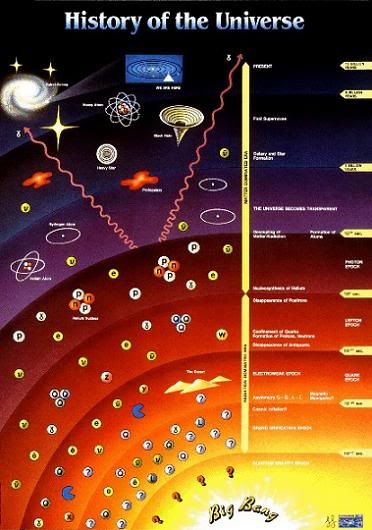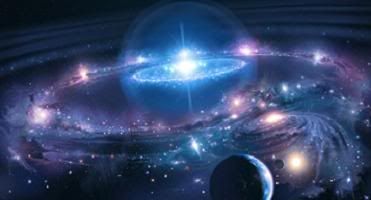Post by glactus on Jun 9, 2011 1:49:59 GMT

History of the Universe
Why did it happen. How did it happen, how vast is the Universe, how old is it and what is its destiny. These are questions that often go through our minds as we look towards the heavens on a dark and starry night.

Evolution
Why did it happen? - Because there can never be nothing, always something, and that something must be made up of one or mare of the three known elements, liquid, solid and gas. In this instance, that something was gas. All things are made up of atoms and over billions of millenniums and throughout the Universe gas and dust particles congested into enormous clouds, each measuring millions of light years across. The two lightest elements, hydrogen and helium dominated these clouds accounting for 92% and 8% of atoms respectively. Dust particles contributed only 1% of total cloud mass. These clouds contained carbon based organic compounds, the building blocks of life.

A Solar System
How did it happen? - Over billions of years gravity would cause these clouds to collapse, and millions of years later gravity would squeeze these shrinking clouds to temperatures high enough to ignite thermo-nuclear fires. Mammoth nuclear explosions occurred and thousands of billions of hot new stars were born. Clusters of these stars began to revolve and formed a gravitational field which pulled in other stars and eventually these clusters began to turn as one and became Galaxies. The Stars themselves threw bits off and the Planets were formed, smaller nuclear reactions just like that of our own planet Earth. Volcanoes and earthquakes always remind us of what's going on deep inside our world - a perpetual nuclear reaction.
4.7 billion years after our Star was formed, intelligent beings emerged who would ask questions of their origin - the Universe, our galaxy, our Star and our Solar system. All these owe their existence to a collapsed gas cloud 5 billion years ago.
How vast is the Universe? - We can only go by what we see, which is that Galaxies are receding from each other at ever increasing speeds, leaving dark Matter in the voids. We can only see those galaxies which recede within the speed of light, for when they recede at that speed there is a shut off, and we can no longer see them. This means that we cannot calculate the vastness of the Universe, for there are galaxies we can see (The known Universe) and billions of galaxies that have receded out of our site for billions of years. We can estimate the galaxies we can see - probably as many as 200 billion,- and maybe another 200 billion that have receded from us at the speed of light.
What is its destiny? In the end we will only be able to see and to study the Milky Way and the Andromeda Galaxy when they converge into one in a few billion years, and then here will be one massive supergiant, and we will be all alone, a Citadel, in the vastness of the Universe, space and time.
To see movies of the size of the Universe and the Known Universe, click on the URL's below. Have sound
www.youtube.com/watch?v=b0lxbzgwW7I\
www.youtube.com/watch?v=17jymDn0W6U
Waiting for Andromeda
Credits: these are NASA/JPL images
Text by Wikipedia/Glactus
Videos: The size of the Universe by Youtube
The Known Universe by AMNH
Telescope in Avatar: Meade 16" LX 200
Astronomer in avatar: Glactus


